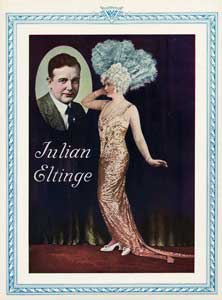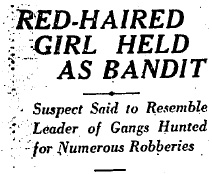Gentle reader,
What are you doing Saturday afternoon? Will you be among the lucky citizens exploring the strange secrets of the San Gabriel Valley and feasting on juicy dumplings on a concrete sea monster, or will you bored and kicking yourself for not getting on the Crime Bus? Read on for all you need to know to avoid that sad fate.
For this Saturday, September 29, Esotouric’s Crime Bus offers a rare edition of its wackiest true crime and history tour, Blood & Dumplings. Tickets for the four-to-five hour luxury coach tour, including dumplings, are $60. Heading due East out of downtown for points rarely seen, the tour explores several historic communities that reflect the growth and eccentricity that are hallmarks of 20th century Los Angeles.
Crime Bus passengers will be treated to detailed descriptions of some of the most notorious, strange and fascinating forgotten tales from the past hundred years, each told at the scene of the crime. They’ll thrill to the freakish case of the Man from Mars Bandit who stalked area supermarkets for months in 1951 before meeting his match in a police sharpshooter, shock to discover the deadly infighting among El Monte’s American Nazi Party members, mourn the Case of the Buried Bride dragged beneath her home on her wedding day by her secret lover, gnash teeth at the weird lion farm (home to every MGM lion) that served lion meat barbecues on special occasions, and visit scenes of notorious cases including Phil Spector’s spooky hilltop castle, James Ellroy’s murder victim mother Geneva (the true-life inspiration for his Black Dahlia novel), neglected Manson victim Steve Parent and even an obscure East LA link to the JFK assassination.
And since no visit to the San Gabriel Valley is complete without a delicious Chinese meal, the Crime Bus will stop at 101 Noodle Express (one of Jonathan Gold’s picks for 99 L.A. restaurants not to be missed) to pick up a dumpling feast, which will be enjoyed picnic-style at Monster Park, a remarkable sea-themed folk art environment recently saved from demolition. There passengers can enjoy their snack in the mouth of a concrete whale, or under a grinning octopus, then pose for photos with the creatures.
All this, plus stunning mid-century trailer parks, subterranean Black Panther hideouts, wild shootouts, dope-dealing druggists, missing Salvador Dali paintings, the original "little girl down a well" television sensation, and a very strange story about ducks.
This tour is my personal favorite of all our tours, packed with more offbeat history, horror, roadside architecture and fabulous Route 66 vistas than any other. We don’t offer it very often, and I highly recommend it to anyone who has been thinking about getting on the Crime Bus.
And don’t forget, we offer 15% discounts for KCRW members, gift certificates, and Season Pass deals ($30 off four tours for one person) that can be applied retroactively for recent passengers.
For more info on Esotouric, or to reserve your seat, visit
https://www.esotouric.com
Upcoming Esotouric bus tour schedule:
Sat Sept 29 – Blood & Dumplings (San Gabriel Valley true crime tour)
Sun Oct 7– Reyner Banham Loves Los Angeles (architecture/urbanism tour)
Sat Oct 20– The Real Black Dahlia tour
Sun Oct 21 – Where the Action Was (rock history tour)
Sat Oct 27 – Haunts of a Dirty Old Man: Charles Bukowski’s LA
Sun Oct 28 – Hallowe’en Horrors featuring Crimebo the Clown







 downtown shopping trip with her mother, Mrs. Agnes Wagner.
downtown shopping trip with her mother, Mrs. Agnes Wagner. 
 Famed vaudeville cross-dressing act Julian Eltinge performed today at the Orpheum, though the Times reported him to be "a trifle too old and portly to exactly suggest the flapper — his impersonation is limited to the more matronly of the species." Eltinge was approximately 46 (reported birthdates vary), and had been doing female impersonations in his act for over 35 years.
Famed vaudeville cross-dressing act Julian Eltinge performed today at the Orpheum, though the Times reported him to be "a trifle too old and portly to exactly suggest the flapper — his impersonation is limited to the more matronly of the species." Eltinge was approximately 46 (reported birthdates vary), and had been doing female impersonations in his act for over 35 years.
 The Fascinating Widow, a musical comedy where he played both male and female roles, the latter of which would become his signature role. Eltinge was a hit, marketing his own line of magazines featuring beauty tips, as well as a line of cosmetics. Ads for his cold cream read, "See what the Julian Eltinge cold cream does for a man. Imagine what it will do for a woman."
The Fascinating Widow, a musical comedy where he played both male and female roles, the latter of which would become his signature role. Eltinge was a hit, marketing his own line of magazines featuring beauty tips, as well as a line of cosmetics. Ads for his cold cream read, "See what the Julian Eltinge cold cream does for a man. Imagine what it will do for a woman."
 Dorothy Parker’s well-known verse, published in her 1926 collection Enough Rope, assured readers that they "might as well live." However, this admonition proved impossible for many today in the Southland, as three men turned blades upon themselves in a veritable rash of unrelated suicides.
Dorothy Parker’s well-known verse, published in her 1926 collection Enough Rope, assured readers that they "might as well live." However, this admonition proved impossible for many today in the Southland, as three men turned blades upon themselves in a veritable rash of unrelated suicides.




